The convenience of a one-click ETF is tempting, but in times like these, buying one can seriously cap your upside—and cause you to leave serious dividend cash on the table, too.
I know that’s a controversial statement, with the millions of ETF fanboys and fangals out there, so let me explain why you do not want to pile into these vehicles during a bear market like this one.
True to its name, it holds the stocks that pop into most people’s minds when they think about dividends, like Johnson & Johnson (JNJ), Procter & Gamble (PG), Verizon Communications (VZ) and Pfizer (PFE).
Trouble is, these so-called “high-dividend-yield” stocks don’t pay high dividends at all! As I write, VYM yields 3.6%.
That’s well above the S&P 500 average of around 2%, but it’s still ho-hum in 2020, when a double-digit drop in the market has increased the yields on many individual stocks to far higher levels.
Just by “cherry-picking” everyday stocks, for example, you can grab a growing 8.2% dividend, like the one paid by 145-year-old insurer Prudential (PRU). Buying AT&T (T), another dividend go-to, will get you an easy 7.1% payout.
Cheap Fees, Lame Returns
When it comes to upside, VYM is also at a disadvantage because it’s tied to the FTSE High Dividend Yield Index, which includes the highest-yielding US companies, save for REITs. The fact that VYM is glued to that index means you’ll pay a pittance in fees, just 0.06% of assets.
Unfortunately, you’ll get what you pay for. With no human manager to steer around the many landmines in the high-yield universe, VYM has been crushed in the last year, including in this crisis—even with its so-called high dividends included!
“High Yield” ETF Lags
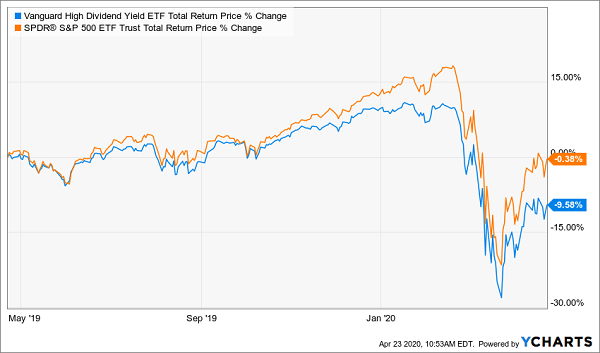
I’m not just picking on VYM here—there are plenty of ETFs that perform worse, while charging higher fees.
Fortunately there’s a better option—one that lifts your yield from 3.6% (or less, if you invest in the average S&P 500 name) to an income stream more than twice as big. Plus you’ll nicely set yourself up for big gains, too.
A One-Stop Shop for 8.6%+ Dividends
No, we’re not going to painstakingly assemble an income portfolio stock-by-stock. We’ll stick with funds, but we’re going to skip over ETFs and invest through their (distant) cousins: closed-end funds (CEFs).
Here are three terrific CEF options. All are cheap in relation to their net asset value (NAV, or the value of the stocks in their portfolios); they’ve crushed comparable “high-dividend” ETFs; and they pay big dividends, yielding 9.3%, on average.
3 Bargain Funds With Big Payouts (and Upside)

ADX: Built for a Crisis
Readers of our CEF Insider service will recognize the Adams Diversified Equity Fund (ADX). It was founded in 1929, on the eve of the Great Depression. Like VYM, ADX gives you some of the biggest S&P 500 names, with JPMorgan Chase (JPM) and Coca-Cola (KO) major holdings of both funds:
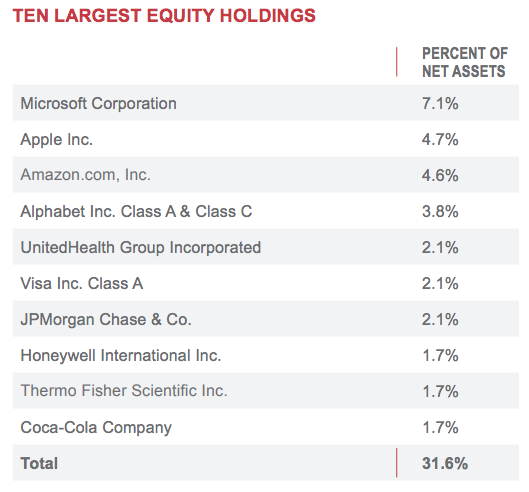 Source: adamsfunds.com
Source: adamsfunds.com
But unlike VYM, ADX is run by a three-person team with a combined 100 years of experience. That’s helped deliver impressive returns: ADX has crushed its “high-dividend” ETF cousin, going by NAV.
Strong Gains, Big Cash Payouts
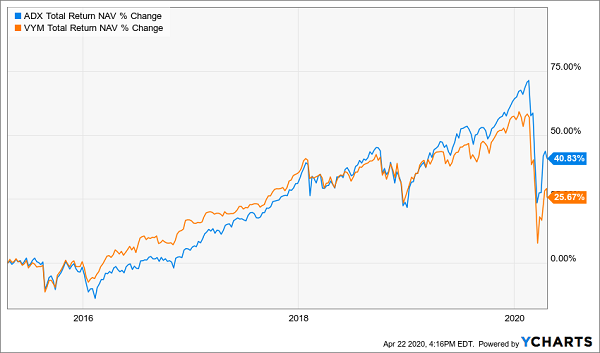
And ADX really is a high payer: as I write, it yields 10%, based on its last 12 months of dividends. But it’s how the fund pays its dividend that stands out.
ADX’s management is committed to a 6% yearly distribution, but it usually pays more. It does so through two distributions of $0.05 a share, in February and June, with the rest coming as a variable payout in December. (This is why ADX’s yield is much lower on most stock screeners—this “special” payout isn’t included.) In 2019, the end-of-year dividend brought the fund’s annual yield to a whopping 9.6%.
This approach frees up management to invest and cuts the risk of a drop in ADX’s stock if it does reduce its dividend. Either way, we can be assured there will be a payout: the fund has paid dividends for 84 straight years.
ASG: 8.4% Dividends Today, Upside Tomorrow
The Liberty All-Star Growth Fund (ASG) has a similar dividend setup through its commitment to pay out 8% of NAV per year.
It’s another flexible policy that’s delivered big income, despite the “growth” in ASG’s name. Based on its last 12 months of payouts, ASG sports a forward yield of 8.4%. It’s also crushed the S&P 500, with virtually all of its gains coming as dividends:
ASG Beats the Market—in Cash
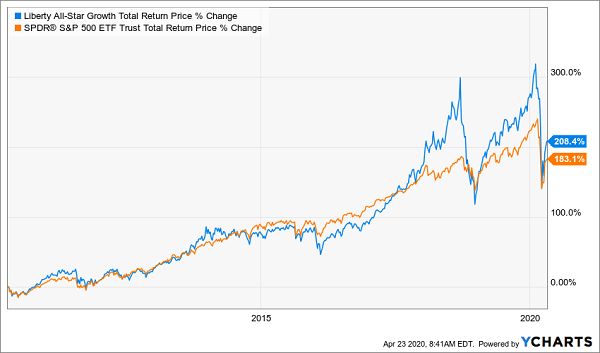
ASG taps three management firms with different focuses—small-cap, mid-cap and large-cap stocks. To keep things unified, they’re monitored by the fund’s advisor.
The result is a fund that’s nicely tilted toward our current situation, favoring IT firms—Amazon.com (AMZN) and Microsoft (MSFT) are top holdings—and healthcare stocks, like medical-device maker Nevro Corp. (NVRO) and insurer UnitedHealth Group (UNH).
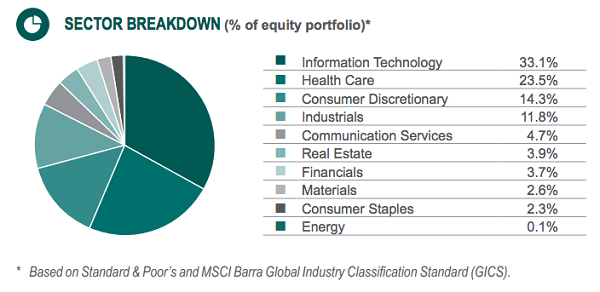 Source: ASG fact sheet, March 31, 2020
Source: ASG fact sheet, March 31, 2020
IT and healthcare are 56.6% of the portfolio, and there’s moderate exposure to consumer-discretionary and industrial stocks, positioning ASG for gains as lockdowns ease. That, plus the dividend, should put this growth (and income) fund high on your list.
UTF: Prime Time for Infrastructure
Readers of my Contrarian Income Report service will recognize UTF: it gave us a 95% total return in the nearly three years we held it, from February 2016 to December 2019.
We only sold this sturdy fund because its discount to NAV had closed entirely, making its price basically the same as its per-share portfolio value. (This is how we tell if a CEF is cheap—and we almost always demand a discount.)
But we’ve kept UTF on our radar, for three reasons: Cohen & Steers is one of the savviest shops in CEF-land; infrastructure will attract investment (especially in post-crisis stimulus packages); and UTF boasts a rock-solid monthly payout:
UTF’s Dividend: Built to Last
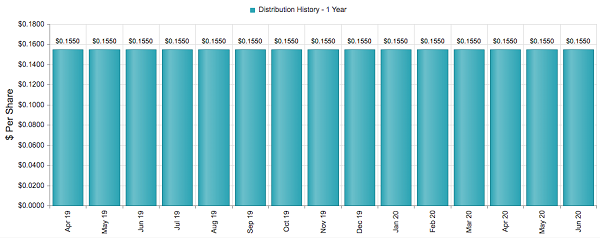 Source: CEF Connect
Source: CEF Connect
UTF is nicely set up for these times, with stalwart utilities like NextEra Energy (NEE), cell-tower owners American Tower (AMT) and Crown Castle International (CCI), and American Water Works (AWK) among its top holdings.
We can buy UTF at an 8% discount today, and it traded at a 1.4% premium as recently as November. That makes it worth a closer look.
— Brett Owens
How We’ll Get 10% Dividends, Paid 12 Times a Year (Do not miss this) [sponsor]
I don’t know why you’d mess with skinflint ETFs when generous payers like ASG, UTF and ADX are hiding in plain sight, begging to be bought.
Actually, I do know why these CEFs get little attention—the press ignores them! It’s just too much work for them to dig into CEF-land when they can blather on about the newest ETF, or the latest tech from Tesla (TSLA) or Apple (AAPL).
That’s fine by us—it leaves us much more room in the dividend shopping aisles!
You won’t have to do any legwork, either, because I’ve put together my 10% Monthly Dividend Portfolio to give you the best high yielders out there, with the safest payouts and biggest upside. As the name says, these rock-solid funds pay dividends monthly, too!
And that 10% figure is just the average. Check out this breakdown:
As I write, 8 of my recommendations throw off yields over 7%. Five pay over 9%. Three clock in above 10%.
And that’s not even the highest.
Our top yielder delivers 15% in dividends to investors who buy in now. That means you’d only need a $500,000 nest egg to pull in $70,000 of income a year!
Full details on this breakthrough portfolio are waiting for you. Click here to get the whole story on these stout monthly payers: names, tickers, dividend histories, buy-under prices—everything you need to know before you buy.
Source: Contrarian Outlook

